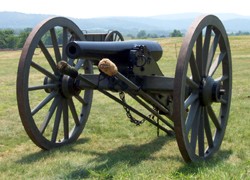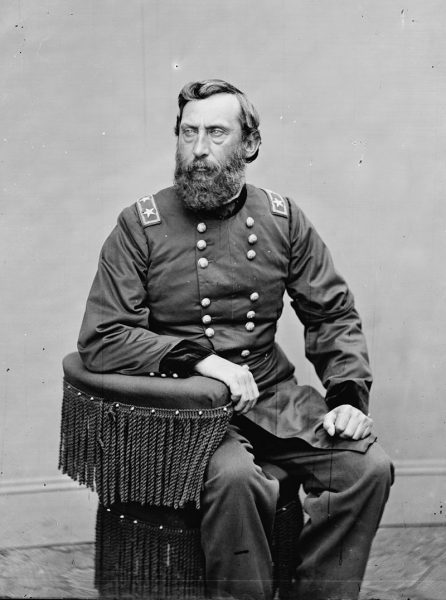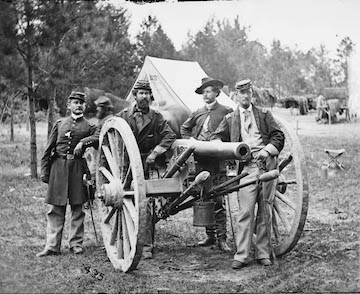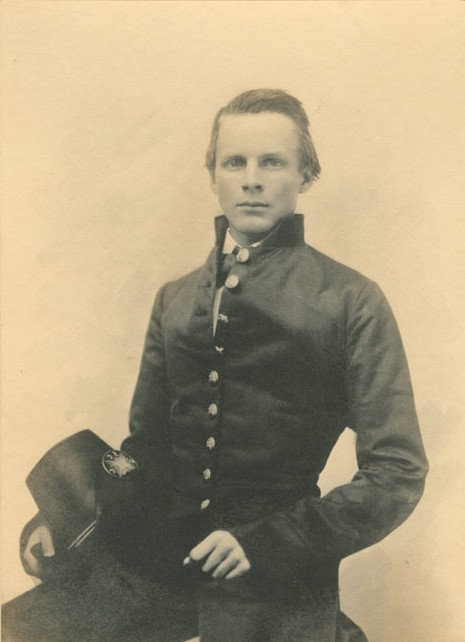The Evolution of Cavalry Tactics: How Technology Drove Change (Part Seven)
(part seven in a series)

In the previous two installments of this series (here and here), we examined how the development of rifled muskets made Napoleonic cavalry charges obsolete, and also how repeating weapons transformed the mission of cavalry from the traditional roles of scouting, screening, and reconnaissance to being a mounted strike force with a vast amount of firepower that it could bring to bear quickly.
In this installment, we will examine the last technological advancement that greatly impacted the use of cavalry in the Civil War: the development and extremely effective use of horse artillery by both sides.
Historically, there were two types of field artillery serving with armies: mounted artillery and horse artillery. With mounted artillery, teams of eight horses or mules drew the guns, and teams of horses and mules also drew the limbers and caissons. The soldiers assigned to man the guns of mounted artillery either walked, or they rode on the caissons and limbers.
By contrast, with horse artillery, each man assigned to the battery had his own mount, meaning that they were able to keep up with cavalry as it moved in the field. In short, horse artillery was a hybrid of cavalry and artillery. This is Dennis Hart Mahan’s definition of horse artillery: Mahan’s definition of the role of horse artillery: “The horse-artillery is held in hand for decisive moments. When launched forth, its arrival and execution should be unexpected and instantaneous. Ready to repair all disasters and partial reverses, it, at one moment, temporarily replaces a battery of foot, and at the next is on another point of the field, to force back an enemy’s column. In preparing the attacks of cavalry, this arm is often indispensable and always invaluable; brought with rapidity in front of a line, or opposite to squares of infantry, within the range of canister, its well-directed fire, in a few discharges, opens a gap, or so shakes the entire mass, that the cavalier finds but a feeble obstacle, where, without this aid, he would in vain have exhausted all his powers.”
The men were trained to move from place to place, and to then quickly dismount, unlimber, and aim their guns, meaning that they could be brought to bear quickly and effectively in the field. Highly proficient, well-trained batteries of horse artillery could do so in a minute or so.

Horse artillery developed in Europe as a means of providing light, fast-moving, effective artillery support for cavalry. Frederick the Great was the first to form a regular horse artillery unit in 1759. Horse artillery was used extensively and effectively during the Napoleonic Wars. The U.S. Army introduced so-called “flying batteries” of horse artillery during the Mexican War, where those batteries, under command of Maj. Samuel Ringgold, played a significant role in several American victories, including the critical Battle of Palo Alto. As a result of the critical role of the horse artillery in the Mexican War, it became an integral component of U.S. Army doctrine.
The premier artillerists in the U.S. Army in the period immediately preceding the Civil War were Henry Hunt, William F. Barry, and William H. French. They helped to develop the concept, which they based on the Mahan concept. It evolved as a variation of artillery to meet the requirement of greater mobility in order to better influence rapidly changing situations. During the early part of the war, Hunt, the chief of artillery for the Army of the Potomac, typically retained the horse artillery brigades as part of the army’s artillery reserve, although that changed in 1863.
In the 1850’s, the experiences of the Mexican War demonstrated that six pound smoothbore guns lacked sufficient oomph to be of any real value and that howitzers lacked range. This led to the development of the twelve-pounder brass Napoleon smoothbore gun. Its larger caliber meant that it could be more effective, but its reduced weight meant that it was more mobile than a standard twelve pound field gun. Although the Napoleon was not originally conceived as a horse artillery weapon, it met the requirement that an eight horse team could bring it into battle, and made it the early choice for the U.S. Army’s horse artillery batteries. However, a technological advance caused yet another evolution.
Civil War horse artillery typically employed three-inch ordinance rifled guns, which had a 3-inch bore, with a barrel that was 69 inches long and weighed 820 pounds (1720 pounds with carriage). A one-pound powder charge fired a 9.5-pound solid projectile 1,830 yards (at 5 degrees of elevation) at a velocity of 1,215 feet/second. The standard three-inch ordnance rifle of the Civil War was developed in 1861 (which is why these guns are sometimes called Model 1861 guns), and was immediately put into widespread use. These guns had an effective range of more than a mile, could be moved quickly and easily, and were highly accurate. Thus, the cavalry of both sides greatly prized them during the Civil War. However, not all of the horse artillery batteries were armed with three-inch ordnance rifles; at least one was armed with smoothbore Napoleon guns that were also used effectively in the field.
West Point-trained Regular Army officers and Regular enlisted men typically manned the Union horse artillery batteries. These men were professional soldiers who were extremely capable and accomplished artillerists. There were as many as twelve batteries of horse artillery assigned to the Army of the Potomac throughout the Civil War. Most of these batteries started out with three sections of two guns per section, but in 1864, the Army of the Potomac’s batteries were reorganized to two sections of two guns each, for a total of four guns per battery. Two brigades of horse artillery were organized and assigned to serve with the cavalry.

Capt. John C. Tidball, a West Point classmate of Brig. Gen. John Buford, commanded one battery, and Capt. James M. Robertson, a grizzled Regular, commanded the other. These batteries performed exceptional service throughout the Civil War. As just one example, Battery M, 2nd U.S. Artillery, commanded for much of the war by Lt. Alexander C. M. Pennington, often served with Brig. Gen. George A. Custer’s Michigan Cavalry Brigade with great distinction; the guns of Pennington’s and Capt. Alanson M. Randol’s combined Batteries E and G, 1st U.S. Artillery, blasted the Union artillery off the battlefield on East Cavalry Field at the Battle of Gettysburg and played a critical role in the Union victory there. Lt. John H. Calef’s Battery A, 2nd U.S. Artillery, formerly commanded by Tidball, played a crucial role in the stand by Buford’s cavalry on the first day of the Battle of Gettysburg; one of Calef’s guns fired the first Union artillery shot of the battle that morning.
Perhaps the best example of how horse artillery made the Union cavalry more effective was Lt. Edward B. Williston’s use of his Battery D, 2nd U.S. Artillery on the second day of the Battle of Trevilian Station, June 12, 1863. Williston’s battery of horse artillery typically served with the Reserve Brigade of the 1st Division, Cavalry Corps, Army of the Potomac. Williston fought his battery, armed with four Napoleons, like it was dismounted cavalry and not artillery. Williston deployed his guns on the main Union line of battle, and it advanced with the cavalry as it launched attack after attack on the Confederate position there. After repulsing seven separate attacks, Confederate commander Maj. Gen. Wade Hampton, unleashed a savage counterattack that rolled up the Union flank and drove the federal cavalry from the field in a while rout. Williston actually advanced one of his guns in front of the main federal line of battle and personally pulled the lanyard at point blank range. In his report of the battle Reserve Brigade commander Brig. Gen. Wesley Merritt wrote of Williston’s performance, “the light 12’s were magnificent,” and lavished praise on Williston and his artillerists. Consequently, Williston was awarded a richly-deserved Medal of Honor without much fanfare in the 1890’s.

The Army of Northern Virginia also boasted outstanding horse artillerists. Maj. John Pelham commanded the vaunted Stuart Horse Artillery and led it to glory until he was mortally wounded while foolishly leading a cavalry charge at the March 17, 1863 Battle of Kelly’s Ford. Maj. Robert Beckham succeeded him in command of the battalion of horse artillery serving with Maj. Gen. JEB Stuart’s cavalry and was the unsung hero of the June 9, 1863 Battle of Brandy Station. After Beckham was promoted and transferred west, Maj. James Breathed and Maj. Roger Preston Chew commanded battalions of horse artillery attached to the Army of Northern Virginia’s Cavalry Corps to great effect.
Horse artillery greatly enhanced the effectiveness of the evolving role of cavalry during the Civil War. The introduction of the three-inch ordnance rifle in 1861 greatly extended the range of the cavalry. These technological advances caused cavalry tactics to evolve, and eventually played a major role in the dominance of the Union cavalry in the Eastern Theater of the Civil War during the second half of the war. Horse artillery eventually evolved into modern self-propelled artillery as used in the contemporary army. Hence, no study of the role of technology in causing the evolution of cavalry tactics during the Civil War can be complete without an examination of the role played by the horse artillery.
I am grateful to Craig Swain for his assistance with this article. Thank you, Craig.
I don’t understand this sentence, “the guns of Pennington’s and Capt. Alanson M. Randol’s combined Batteries E and G, 1st U.S. Artillery, blasted the Union artillery off the battlefield on East Cavalry Field at the Battle of Gettysburg and played a critical role in the Union victory there.” Did you mean to say, “blasted the Confederate Artillery off the field”?
Yes. Sorry.
To leave Morton’s Horse Artillery out of this article was a major oversight. It was arguably the most accomplished Horse Artillery Battery of the war. Its service at Brice’s Crossroads and Johnsonville are remarkable as well as it’s good work on Hood’s retreat from Nashville. Great article by the way.
I’m not sure I’d describe it as a “major oversight”. The article is a discussion of developments in tactics, not a list of the best units. All due respect to Morton’s battery but horse artillery was a more ubiquitous subset of field artillery in the Virginia theater and it was there that tactics evolved with its use. As an aside, I’d stick any of the units from either side which are mentioned in the article up against Morton’s, but in that respect we’re each entitled to our respective opinions..
Eric: Thanks again for another excellent contribution.
There is an interesting dispute over the first true “horse artillery” in the U.S. service. William Birkhimer, in his seminal 1884 study of the history of that arm asserted that in 1838 the first “horse artillery” battery, Battery C of the 3rd U.S., was organized under the command of Capt Samuel Ringgold (who in 1845 adapted the 1839 French instruction in his manual for both “foot and horse” artillery). The other “flying batteries” which fought in the War with Mexico were not true “horse” artillery in the sense that every member was mounted. In 1890, however, John Tidball (the bearded gent second from the left in the photo) asserted that Birkhimer was wrong and that Ringgold only on occasion fully mounted only one section of Battery C. Tidball claimed that Battery A of the 2d U.S (his at the outset of the ACW), was the first fully mounted battery in U.S. service. It was Tidball who fully mounted Battery A. Tidball’s successor, Calef, unsurprisingly, later agreed with Tidball in a 1907 publication. The dispute is colored by the fact that Birkhimer served in the 3rd himself (albeit obviously after the events in question, since he was born in 1848). I don’t recall offhand what Tidball relied on but he did claim that he looked into the question when he mounted Battery A.
In a while rout?